|
Antiques and The Arts Weekly — October 4, 1991
Auction
Action in Philadelphia, Pa.
$2.27 Million Grossed at Bertoia/Brady Bank Auction
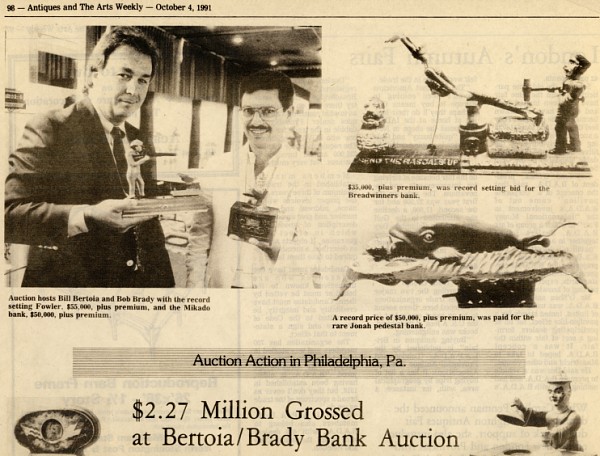
(web note — additional images with
descriptions after text)
PHILADELPHIA, PENN.
It was exactly five years to the day since Bill Bertoia had marched
into the main ballroom of the Philadelphia Hilton Airport Hilton and
made history by conducting one of the most successful toy auctions ever,
that of The Atlanta Toy Museum. With several eventful escapades added to
his list of achievements during the interim, Bertoia once again strode
confidently into the Airport Hilton on September 14 to conduct another
history making sale by offering the Bill Norman Mechanical Bank
Collection.
Bertoia with his most recent partner Bob Brady, succeeded in once
again sending shockwaves throughout the normally stable toy-world by
conducting a gangbuster auction which established more record setting
prices than you could shake a stick at. The auction featured some 400
lots and grossed an impressive $2.27 million dollars after premium. More
than 35 records in the over $10,000 category were established, along
with a virtual plethora of records in the $3-5,000 range.
For lack of 20 pages to cover this auction, we will concentrate
only on the big ticket items. Sixty banks in the sale exceeded $10,000,
which accounted for slightly more than half the auction gross by
themselves, totaling some $1.2 million. Five of the banks offered either
tied or broke the previous record price paid at auction for a mechanical
bank, which was established earlier this year by Mike Clum when he sold
a near mint Circus bank with box for $55,000. (No buyer's premium was
charged at Clum's.)
The Norman Collection was rated prior to the sale as one of the top
three collections of mechanical banks in the world. It was regarded not
so much for rarity, although there were certainly enough highly
desirable banks to make most any collector envious, but for being the
premier collection of banks in prime condition. Words such as "mint,
near mint," and "pristine" followed virtually every lot in the
descriptive text of the catalog with an occasional "very fine condition"
representing the lower end of the condition reports.
Bertoia got his start in the auction business with then-partner
Noel Barrett at the Atlanta Toy Museum sale, but the two parted ways
after that auction. He then teamed up with Madison Avenue's Alex Acevedo
for several hair-raising events. Bertoia and Acevedo conducted the
legendary "Tag Sale" at the Perelman Toy Museum, which was closely
followed by the renowned sale of the Hegarty Bank Collection. With
collectors still reeling from those two record setting mega-events, the
duo of Acevedo and Bertoia hammered the toy collecting community once
again with the disposal of the Bernard Barenholz collection in New York
City in 1990.
Each of the sales has created an aura all of its own with record
prices being paid, almost to the point of being commonplace, and an
excitement level which has escalated from one sale to the next. Many
felt that a pinnacle had been reached and that the best was already
over. But, just when serious bank collectors thought it was safe to
resume shopping, up steps Bertoia again, this time with Bob Brady, and
yet another major collection.
The two announced the acquisition of the Bill Norman collection.
Norman authored The Bank
Book, and leaked word of the auction early this past summer.
This set the toy-world abuzz with predictions and all the serious
collectors were frantically making out their "wish lists." As the
catalogs were released a frenzied atmosphere existed at many of the
intermediate levels, while all of the big guns just sat back and kept
their opinions to themselves.
Bertoia termed the collection as the "best mechanical bank
collection to reach the public in the Twentieth Century." It offered
such rare items as trade cards, bronze and lead patterns for the banks,
rare ephemera such as infringement agreements between companies, and,
naturally, some 375 banks in pristine condition.
Several at the sale called this auction "an opportunity of a
lifetime" for serious bank collectors. "This sale provides collectors
with an opportunity to not only pick a bank of their choice, but in many
instances, there are as many as six color variations to choose from,"
said one wide-eyed collector.
Norman began collecting banks in 1979 and during his years of
collecting he acquired banks from many of the premier collections,
including the Perelman Toy Museum and Hegarty tag sales. Other
provenance including Mosler, Carron, Whitting, Weider, and Meyer.
Preview for the auction began the day prior to the sale with a
large crowd spending the majority of the day, and well into the evening,
inspecting each and every bank. Three cases in the center of the room
were glassed on all sides, and due to rarity and condition, these top
lots were not available for the general public to handle. "We don't want
the condition to deteriorate on these banks," reasoned Bill Bertoia,
although after preview closed on Friday evening major clients, and those
who expressed serious interest, were allowed to inspect the banks.
Preview the morning of the sale also proved active and come auction
time most of the 400 seats in the large hall were filled. A crowd in the
range of 350 was estimated by Bertoia and Brady. A large number of
absentee and several phone bids were registered for the sale, yet a
minimal percentage of the lots were won by them.
As the auction got underway, it was apparent that the toy world
would have to brace itself again as premium price levels got pushed
towards the stratosphere and record after record was toppled.
The first few lots set a blistering pace with the offering of a
select group of trade cards. The first lot, a Humpty Dumpty card
estimated as $1/1,350, started it all off by selling above estimates at
$1,800. It wasn't long before the first record price paid at auction was
established as a Watchdog Safe bank trade card soared past the
$1,500/1,750 presale estimate as it sold to a New England collector
Steve Rottman for $5,200, plus premium. Other trade cards included a
Picture bank which brought $4,000, a Bad Accident card $2,500, and a
Mason bank card brought $2,400. All more than doubled their high
estimates, in fact it wasn't until lot 15 that a price realized actually
fell within estimates.
The first bank to establish a record price paid at auction was
Artillery bank, lot 24, which was described by auctioneer Rick Opfer as
"the best known example." Estimated at $4/5,000, the bank opened at
$2,000 and was bid actively by several in the room to a selling price of
$20,000, plus premium. Two other Artillery banks were sold, both listed
as "pristine condition," and both went out above their estimates at
$1,250 and $1,400.
A Bismark Pig bank, which carried a provenance of the Hegarty
collection, sold towards the low end of the estimates as it brought
$10,500 from toy dealer Ray Haradin, a Baby Elephant with replaced trunk
and tail brought $18,000 from Stan Sax, and a butting Ram was bid
successfully by Bob Booth's pre-teenage son for a record price of
$15,000.
The first bank to break into the stratospheric price range was the
Fowler bank, or Sportsman, which was estimated at $20/25,000. Opfer
looked for an opening bid at the high estimate and quickly got a bid
from the rear of the room. Moving in $5,000 increments the bids came
quickly from several collectors in the room until the $45,000 mark,
where the bid was cut to $2,500 increments. At $50,000 Bill Bertoia
stuck a paddle with the number "1" on it, the bid was advanced to
$52,500 from the rear of the room and again Opfer looked to Bertoia who
once again raised the ante. It was at $55,000 that the Fowler bank was
knocked down, with Bill Bertoia trying vainly to conceal a smile.
Bertoia commented after the sale that the number "1" paddle was his
own and that the bank had been bought for his private collection. "Bobby
and I discussed this prior to the sale," said Bertoia, "and we decided
that since we were both among the top collectors that if there was
anything we wanted from the collection we would have to buy it at the
sale. We wanted to offer this collection both unpicked and absolutely
unreserved."
While many in the room felt that this was just a starting point for
the record prices to escalate from, it was a price level which would,
surprisingly, not be repeated during the course of the auction. The bank
was a classic example with paint that was not only in mint condition,
but it also had a patina and colorscheme which made it worthy of the
price. "I have wanted that bank for more than 10 years, " said Bertoia,
"and to get one in this kind of condition (the best known) is the cream
on the cake." Bertoia felt that this bank transcends the collecting
areas. "Due to the fowling theme it would be equally desirable to decoy
collectors and because of the form and paint it also crosses over into
the folk art arena," he said.
The first bank to provide a real shock for the crowd was the Girl
Skipping Rope bank which carried a presale estimate of $21/25,000.
Presale scuttle-butt was that the bank should do $40,000. This bank also
opened at the high estimate and was also subject to rapid-fire $5,000
increment bids. When the bank hit the anticipated level of $40,000
things slowed and the bid was once again cut to $2,500 advances. A
relatively new collector seated in the third row had been hopeful of
getting the bank and seemed determined as he executed his next bid, and
then after being raised, executed another. His bid was once again
raised, and then, seemingly gritting his teeth, collector Jan Piepul
raised his paddle and executed the winning and record setting bid of
$50,000, plus premium.
The next bank to create a big stir was the extremely rare Jonah and
Whale pedestal bank which was estimated at $30/35,000 and was expected
to bring substantially more. Bidding on this lot opened, somewhat
reluctantly compared to the other prime lots, at $20,000 and moved in
$2,500 increments to $32,000. Here the bid was cut to $1,000 and once
again the Jonah on pedestal bank was on the move to the $50,000 mark
where it was hammered down to English collector John Haley.
Fireworks were also expected when the Mikado bank was sold, the
last known example to trade went privately at the Hegarty sale for
$85,000 selling to Bob Brady. That bank was in slightly better condition
and had a red base. When the blue based Mikado said to be the best blue
example known, was offered it opened well below the $50/60,000 estimate
at $25,000 and was bid actively to the low estimate of $50,000 where it
sold to a Midwestern private investor.
The last bank which people thought stood a chance to break the now
stagnant $50,000 mark was Little Red Riding Hood bank, which was offered
during the last quarter of the sale. Estimated at $24/28,000, this small
bank in near mint condition had attracted the attention of all the major
collectors. The unusual small bank depicted Little Red Riding Hood
seated on the edge of Granny's bed. By pulling a lever on the side of
the bank, Granny's head moved forward and revealed the Big Bad Wolf
hiding underneath.
Bidding opened on this lot at $10,000 and soared past the estimates
with all of the action coming from the room. Just as it appeared that
the piece would be sold, Bertoia raised his paddle and within a couple
of advancements won the bank at $52,000, plus premium.
Other top lots which established records included the Roller Skater
bank which sold to Dr Tony Haradin for $45,000, the Picture Gallery bank
at $42,000, Breadwinners at $35,000, and Horse Race at $29,000.
Bill Bertoia reported numerous offers being tendered in the days
following the sale on several of the top lots which were sold. "Several
people sat on their hands or left absentee bids and came away from the
sale with nothing," said Bertoia, "now they realize what a mistake they
made and they're kicking themselves in the backside. They now want us to
tender offers of ten percent profit and more to the successful bidders."
Bertoia commented that one bank which he believes will be sold
immediately is the Mikado which he predicted would move in the
$60,000-plus price range.
If you think this sale was one that can't be beat, then hold onto
your hats because it is in the wind that Bertoia has yet another ace up
his sleeve and may soon be making another announcement.
Prices printed in this review do not include the ten percent
buyer's premium which was charged. For further information regarding
this auction contact Bill Bertoia at (609) 692-4092, or Bob Brady (717)
569-7408.

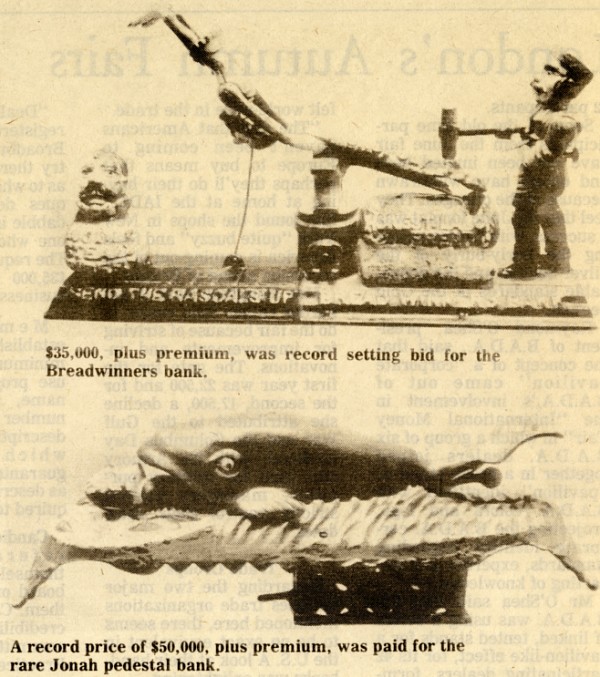

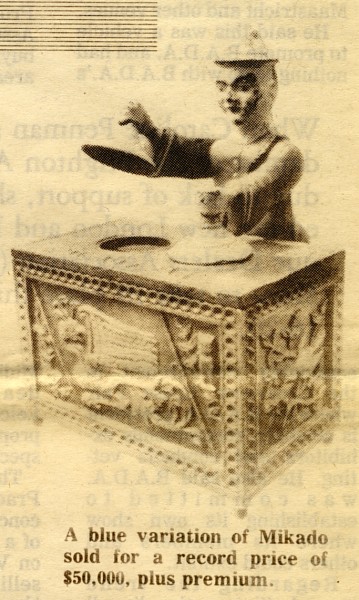

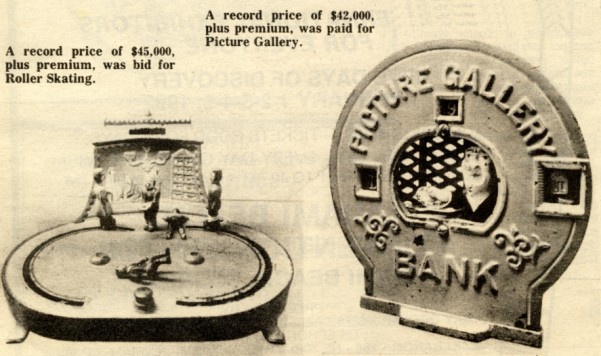
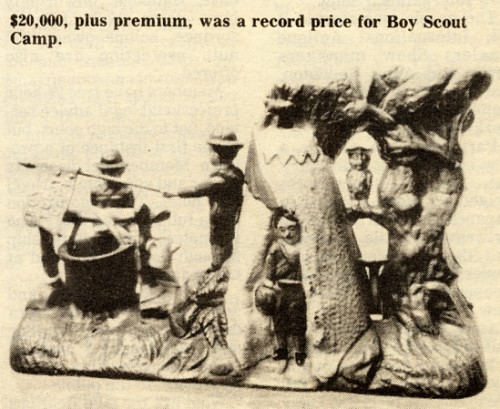
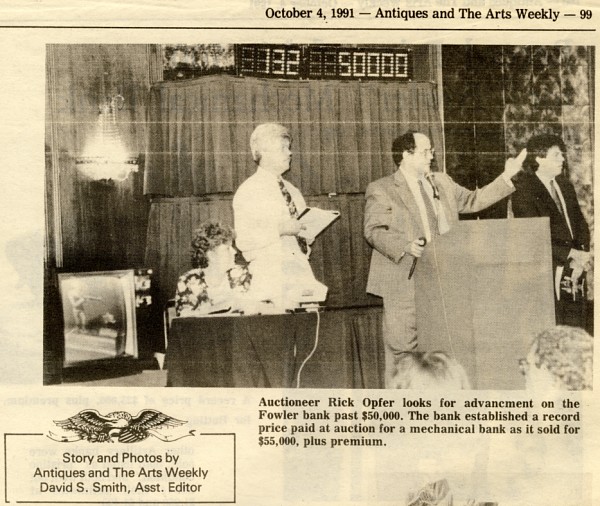
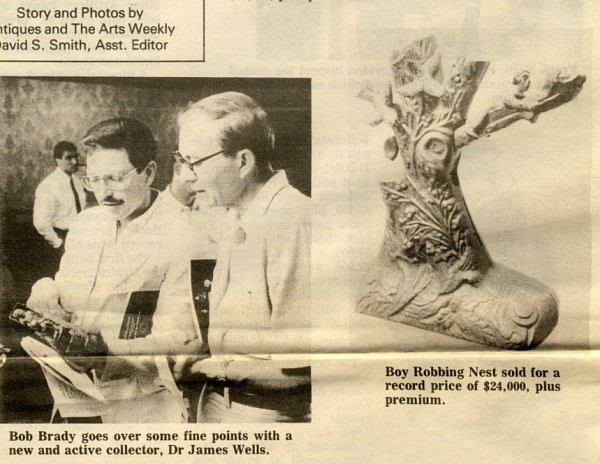
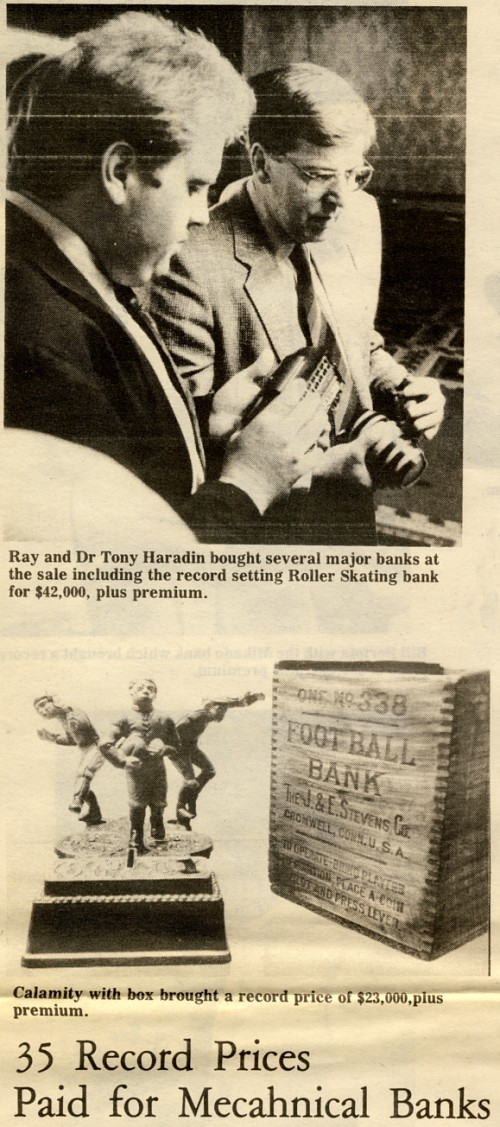
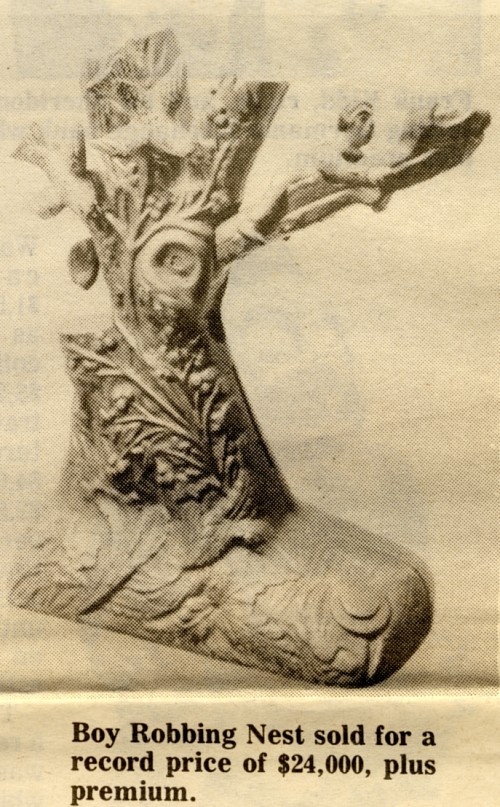
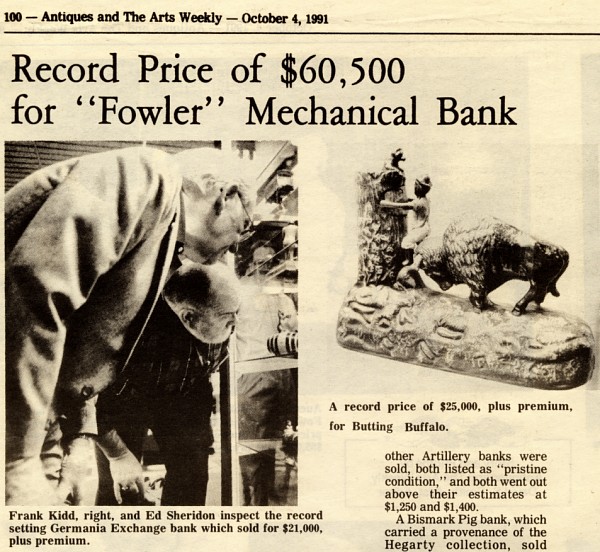
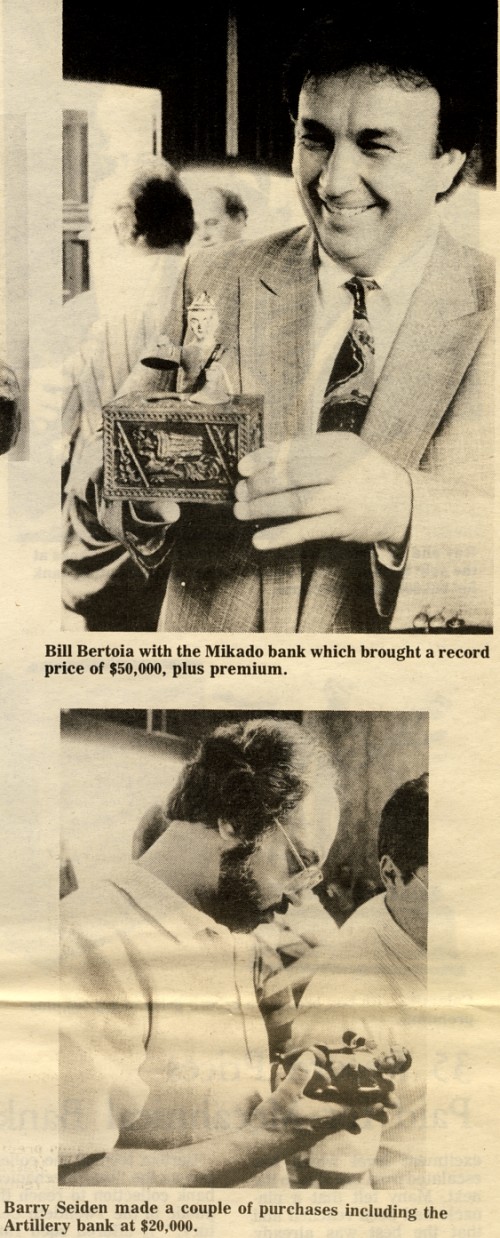
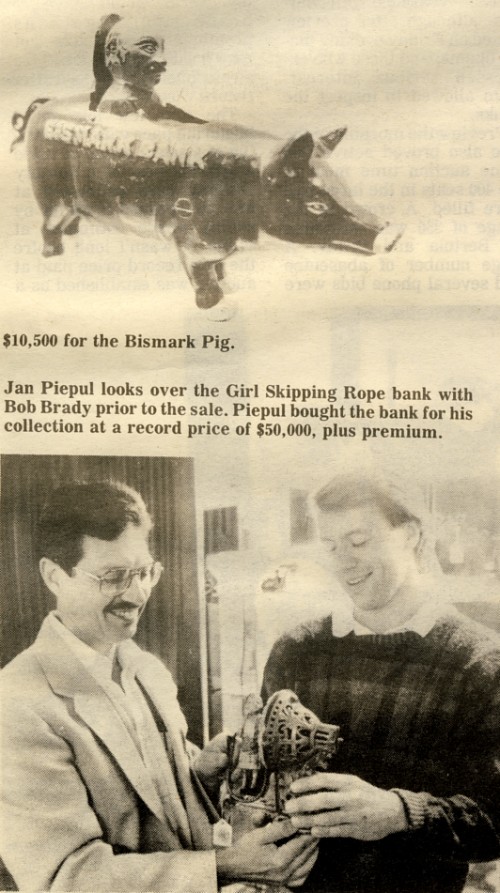

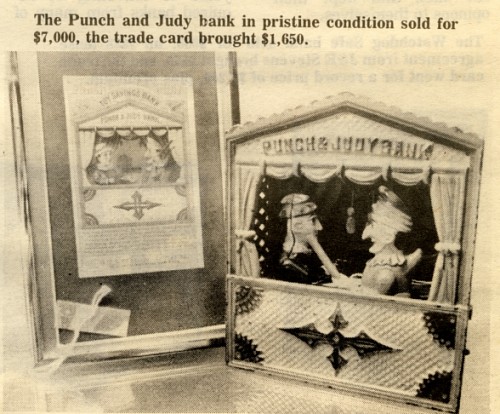
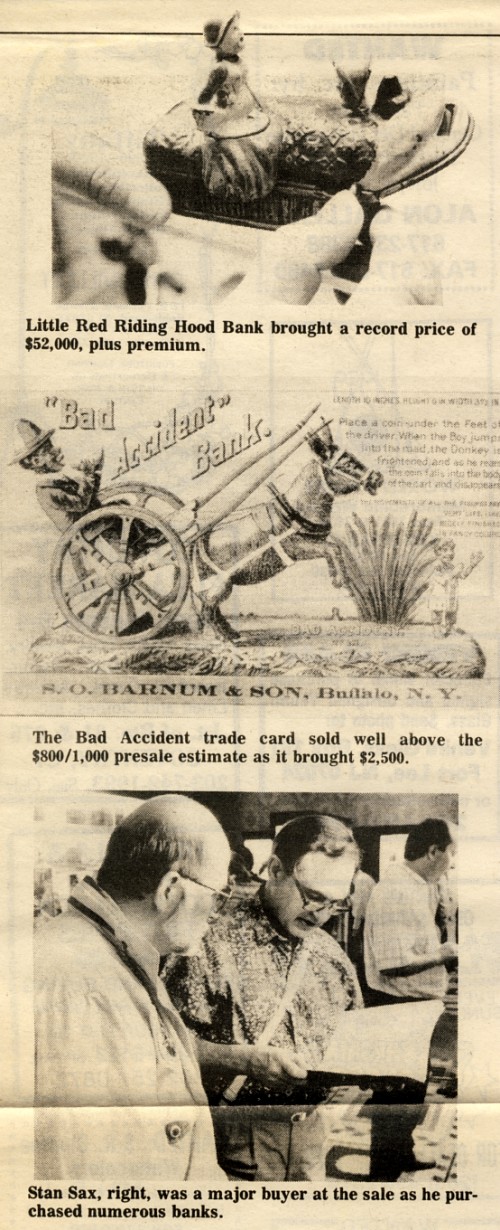
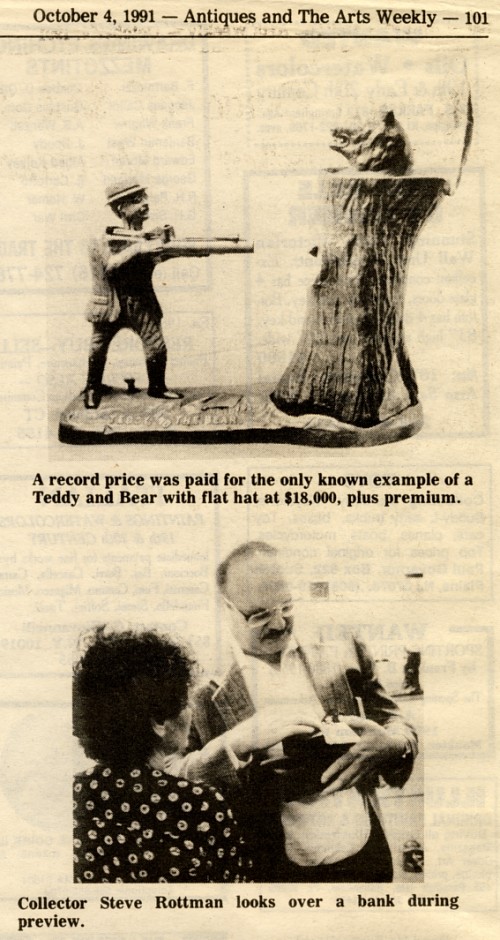
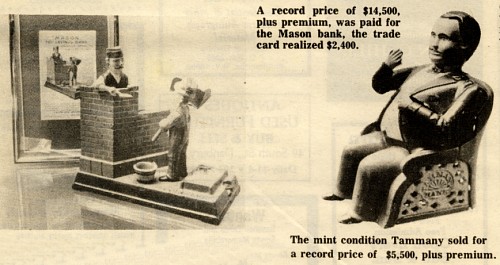
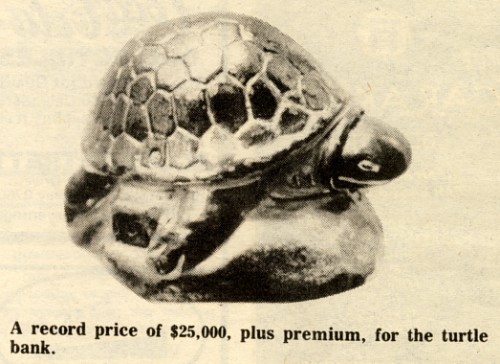
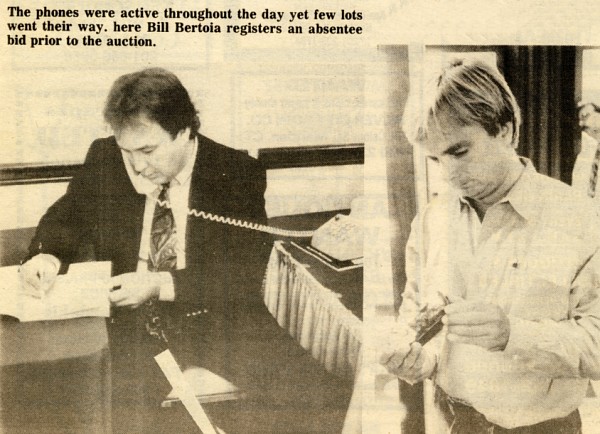

|